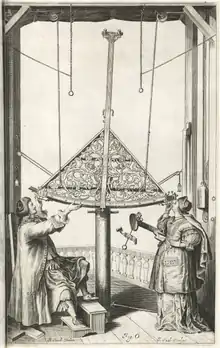Elisabeth Hevelius
Elisabeth Catherina Koopmann-Hevelius (in Polish called Elżbieta Heweliusz; January 17, 1647–December 22, 1693) is considered one of the first female astronomers. She is from Danzig and contributed to improve the work and observations done together with her husband Johannes Hevelius.

Early life
Elisabeth Koopmann (or Kaufmann, German: "merchant") was, like Hevelius and his first wife, a member of a rich merchant family in the city of Danzig (Gdańsk) located in Pomeranian Voivodeship of the Polish–Lithuanian Commonwealth and a member of the trade organisation called Hansa. Elisabetha Koopman's parents were Nicholas Koopman (the Dutch word for "Merchant") (1601-1672) who was a prosperous merchant and Joanna Mennings (or Menninx) (1602-1679). Nicholas and Joanna were married in Amsterdam in 1633.[1] They moved from Amsterdam to Hamburg then, in 1636, they moved to Danzig. It was in this city, largely German speaking but a part of Poland at the time, that their daughter Elisabetha was born.[2]
Marriage


It was a fascination for astronomy which led Elisabetha, when still only a child, to approach Johannes Hevelius, an astronomer of international repute who had a complex of three houses in Danzig which contained the best observatory in the world. The marriage of the sixteen-year-old to fifty-two-year-old Hevelius in 1663[3] allowed her also to pursue her own interest in astronomy by helping him manage his observatory. They had a son, who died soon, and three daughters who survived.[4] The eldest of the three daughters was named Catherina Elisabetha (after her mother) and baptized in St Catherine's Church, Danzig, on 14 February 1666. From the writings of Johann III Bernoulli we know that Elisabetha contracted smallpox and was permanently scarred by it. Following his death in 1687, she completed and published Prodromus astronomiae (1690), their jointly compiled catalogue of 1,564 stars and their positions.
Latin
Scholars know that she wrote in Latin since she had written letters to other scientists in Latin. They wonder why she would have had to learn Latin and why it would have been a priority for her at the time.[5]
Death
Elisabetha Hevelius died in December 1693, at the age of 46, and was buried in the same tomb as her husband. After her death, the mathematician François Arago wrote of her character:[5]
A complimentary remark was always made about Madam Hevelius, who was the first woman, to my knowledge, who was not frightened to face the fatigue of making astronomical observations and calculations.
In Culture
Elisabeth's life was dramatized in the German language historical novel Die Sternjägerin (The Star Huntress)(2006).[6]
The minor planet 12625 Koopman is named in her honour, as is the crater Corpman on Venus.
Notes
- Nicolaes Koopman x Johanna Mennincx, 13 october 1633, Stadsarchief Amsterdam, both from Hamburg ('van Hamborgh')
- Hockey, Thomas (2009). The Biographical Encyclopedia of Astronomers. Springer Publishing. ISBN 978-0-387-31022-0. Retrieved August 22, 2012.
- Stories of Women Stargazers, Dora Musielak, March 30, 2009
- Gotthilf Löschin: Geschichte Danzigs von der ältesten bis zur neuesten Zeit: mit beständiger Rücksicht auf Cultur der Sitten, Wissenschaften, Künste, Gewerbe und Handelszweige, Volume 1, 1828
- "J. J. O'Connor and E. F. Robertson: Catherina Elisabetha Koopman Hevelius". University of St. Andrews. December 2008.
- Eric Walz, Die Sternjägerin. Blanvalet Taschenbuch Verlag. 2006. ISBN 3442365236.
References
- Ogilvie, Marilyn Bailey. "Hevelius, Elisabetha Koopman". In: Women in Science, The MIT Press, 1986, p. 99 ISBN 0-262-15031-X (Short encyclopedia article)
- Walz, E. 2006. The Star Huntress. Random House/Bertelsmann. ISBN 978-3-442-36523-4 (Historical novel)